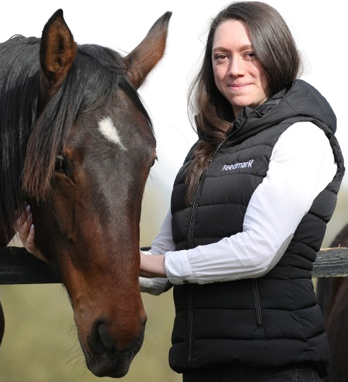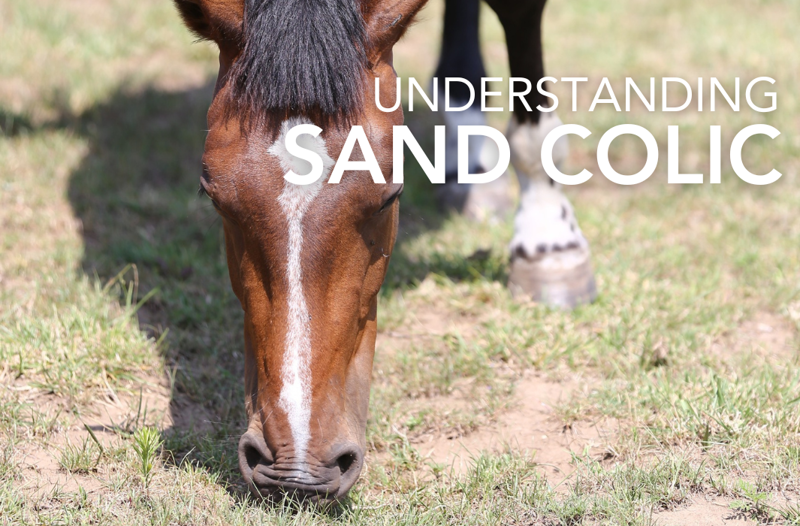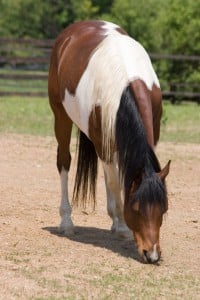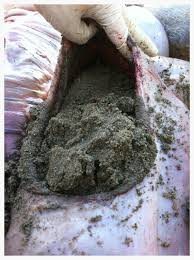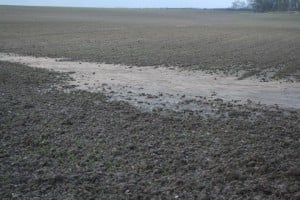Introduction
While it is very uncommon for horses or ponies to intentionally eat sand, they can easily ingest it accidentally - especially when grazing on sandy pastures or eating hay directly off the ground. This is particularly common during the summer when grass is short, or in winter on wet, muddy fields.
Most of the time when sand is ingested by the horse, it will pass through the digestive system with food and be excreted out. However, its abrasive nature can irritate the horse's intestinal lining leading to loose stools, and in larger amounts, sand can accumulate, slowing the passage of food, and causing serious issues such as weight loss, colic, or even impaction.
In this article, we’ll explore how sand enters the horse’s gut, why it can become a problem, and what you can do to prevent it.
How does sand get into the horse's gut?
Horses eat it. Some horses will eat dirt – perhaps because they are salt deficient. On poor grazing, horses may pull up roots and ingest sand with the grass or when turned out in a sand school they may ingest the sand with the hay or through boredom. There is definitely an individual variation related to each horse’s grazing pattern because not all horses on the same paddock will accumulate sand in the gut. We often see an increase in the number of sand colics following a certain weather pattern – after a period of dryness, heavy rain will cause the sand from the soil to splash up onto the grassy leaf and therefore it is impossible to eat the grass without the sand.
Why is the sand a problem in the horse's gut?
Sand is quite rough and can irritate the gut wall as it is dragged along, but most of the problems we see are caused by an accumulation (collecting together) of the sand within the gut. The horse’s gut is about 30 metres long from mouth to anus (bottom). Its’ design involves at least 3 hairpin bends and other dramatic changes in diameter – some parts of the gut are only 4cm in diameter (width of tube that food passes through) whilst other parts have a diameter of at least 10cm. The sudden changes in size and angle of the gut are design faults that make the horse more susceptible to colic.
Sand impaction of the large bowel
Because sand is heavy it sinks as it passes along the gut and it starts to collect at the bottom of the gut forming a layer. This layer of sand stops that piece of gut moving correctly (peristalsis is the technical name for the way your gut pumps food along). Over time this layer gets deeper and quite a “weight” of sand can collect as the rest of the food/liquid just moves along over the top of it. The sand can also accumulate at the hairpin bends in the horse’s gut.
The weight of the sand can affect the horse’s performance – imagine trying to be athletic with a sandbag strapped to your belly! The accumulation of sand and slowing of gut mobility can lead to an impaction (sand blockage). If you have ever tried to wash sand away (for example, clearing up after a beach outing) you’ll have noticed how persistent the sand is at hanging around and blocking the plug hole! This blocking effect is exactly what can happen in the horse’s gut too.
Symptoms of sand accumulation in horses
Because sand can affect the gut in different ways horses suffering from sand accumulation can be ill in different ways. Here are some examples:
- Diarrhoea
- Normal dung with a squirt of fluid at the end
- Intermittent low grade colic
- Heavy (in weight) heaps of dung
- No dung passed
- Bloated/pot belly
- Slow when ridden
- Depressed or just a bit quiet
- Grumpy
- Laying down
- No signs
- Straining to pass dung
- Any other ‘colic’ signs
How do you find out if your horse has any sand accumulation in the gut?
- Test the dung – anything more than ½ teaspoon of sand could be significant.
- Bucket of water – add generous double handful of dung and STIR.
- Leave 10 minutes and stir again.
- Wait one minute and tip out the water and dung and see how much sand is left in the bottom of the bucket (1/2 teaspoon requires action). This is known as a sand dung test.
- Test weekly.
Please note heavy clay soils also contain sand so test your horse even if your soil seems heavy!
East Anglia has recognised sandy areas east of the A12 similar to Holland where sand colic is also a problem.
How can you help to prevent your horse from getting Sand Burdens?
- If you need to feed hay or haylage in the field, provide it on rubber mats or concrete pads that can be easily swept to remove dirt or sand
- Try not to over-graze paddocks: ingestion of sand and soil is much higher when grass length is less than 2 inches!
- Many vets recommend the use of Psyllium husks is a well-recognised way to reduce sand burdens within the gut- these fibrous husks swell, forming a gel like mass once digested and travel through the digestive tract picking up sand and excreting it in the horse's dung.
- If your horse is grazing sandy soil or you are feeding hay from the ground, regular feeding of Psyllium husks, for consecutive days every two months will help to maintain a clear digestive tract. This product should be fed dry, if necessary, layer between dry feed.
Conclusion
Sand accumulation can affect horses in different ways, from mild digestive discomfort to more serious complications like colic. Staying proactive with prevention - such as using feeding mats, managing grazing, and considering supplements like psyllium - can make a big difference, particularly if your yard is on sandy ground. If you notice any signs of discomfort or suspect your horse may be dealing with sand colic, it’s important to get in touch with your vet as soon as possible for advice and appropriate treatment.
For any nutritional advice or questions you may have, please don't hesitate to reach out to our Registered Equine Nutritionist. You can call 0800 585525 Monday-Friday 8:30am-5:00pm, email [email protected], use the Live Chat function on our website, or send us a DM on social media.
Information and photos taken from a prior article written by Helen Whitbread BVetMed CertVR MRCVS for Feedmark. Read that full article here.

